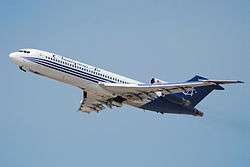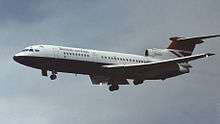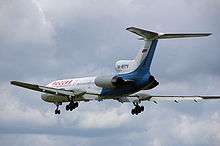Trijet

A trijet is a jet aircraft powered by three jet engines. Early twinjet designs were limited by the FAA's 60-minute rule, whereby the flight path of twin-engine jetliners was restricted to within 60 minutes' flying time from a suitable airport, in case of engine failure. In 1964, this rule was lifted for trijet designs, as they had a greater safety margin. This led to a flurry of trijet designs, which in their heyday of the 1980s were the most popular airliner configuration. However, subsequent improvements in engine reliability and a corresponding relaxation in airline safety rules made the trijet obsolete for normal passenger services, and no manufacturer now produces three-engine airliners.
In general, passenger airline trijets are considered to be second-generation jet airliners, due to their innovative engine locations, in addition to the advancement of turbofan technology.
Other variations of three-engine designs are trimotors, which are aircraft with three piston engines.
Design
One major advantage of the trijet design is that the wings can be located further aft on the fuselage, compared to twinjets and quad-jets with all wing-mounted engines, allowing main cabin exit and entry doors to be more centrally located for quicker boarding and deplaning, ensuring shorter turnaround times. The rear-mounted engine and wings also shift the aircraft's center of gravity rearwards, improving fuel efficiency, although this will also make the plane slightly less stable and more difficult to handle during takeoff and landing. (The McDonnell Douglas DC-9 twinjet and its derivatives, whose engines are mounted on pylons near the rear empennage, enjoys some advantages of the trijet design such as the wings located further after and a more rearward center of gravity.)


One issue with trijets is positioning the central engine. On most trijets they are placed at the tail along the middle, producing some technical difficulties. The central engine is most commonly supplied with air by an S-shaped duct – this is used on the Hawker Siddeley Trident, Boeing 727, Tupolev Tu-154, and Lockheed Tristar, which has reduced drag and improved stability but this is a complicated and costly design. Furthermore, the central engine bay would require structural changes in order accommodate future larger-diameter engines; in the case of the Boeing 727 the central bay was only wide enough to fit a low-bypass turbofan and not the newer high-bypass turbofans which had greater output as well as being quiet enough to meet noise regulations, but such a redesign was prohibitively expensive and so Boeing ended production of the 727 instead of pursuing further development. The DC-10 and related MD-11 use an alternative "straight" layout, which allows for easier engine installation, modification, and access, however, has inferior aerodynamic properties when compared to the S-duct designs.
Placement of the remaining two engines varies. Most smaller aircraft, like the Hawker Siddeley Trident, the Boeing 727 and the Tupolev Tu-154 have two side-mount pylons near the tail, whereas the larger Lockheed Tristar and DC-10/MD-11 mount an engine underneath each wing.
The main disadvantage with trijets is fuel efficiency, as a trijet design will almost always consume more fuel than a comparable twin engine design, resulting in higher operating costs. During the 1970s when trijets and twinjets shared engines of similar output, such as when the DC-10 trijet and Airbus A300 twinjet were equipped both with the General Electric CF6, the additional power from the third engine gave trijets advantages in longer range and/or heavier payload. Since the 1990s with further advancements in high-bypass turbofan technology, large twinjets have been equipped with purpose-designed engines like the Boeing 777's General Electric GE90 and those two engines would match or exceed the output of trijets and even quad-jets. Although trijets are more efficient than quad-jets (four-engine aircraft, whose engines are usually under the wing), the difficulty and complexity of mounting the center engine through the tail will somewhat negate this advantage.
History
.jpg)

.jpg)
The first three-jet designs to fly were the Hawker Siddeley Trident (1962) and the Boeing 727 (1963). Both were compromises to meet airline requirements; tn the case of the Trident it was to meet the BEA's changing needs, while the 727 had to be acceptable for three different airlines. Although collaboration between the manufacturers was considered, it did not come about.[1][1]
Early twinjet designs were limited by the FAA's 60-minute rule, whereby the flight path of twin-engine jetliners was restricted to within 60 minutes' flying time from a suitable airport, in case of engine failure. In 1964, this rule was lifted for trijet designs, as they had a greater safety margin.
With the advancement in jet engine technology being the high-bypass turbofan as well as the wide-body (twin-aisle) for greater passenger/cargo capacity, the trijet design was seen as the optimal configuration for the medium wide-body jet airliner, sitting in terms of size, range, and cost between quad-jets (four-engine aircraft) and twinjets. The four-engine Boeing 747 was popular for transoceanic flights due to its long-range and large size but it was expensive and not all routes were able to fill its seating capacity, while the original models of the Airbus A300 twinjet were limited to short- to medium-range distances. Thus trijet designs such as the DC-10 and L-1011 represented the best compromise with medium- to long range and medium size that US airlines sought for their domestic and transatlantic routes. As a result of these trijet wide-bodies, as well as the popularity of the Boeing 727, trijets made up a majority of all such US jet airlines by 1980.
From 1985 to 2003 the number of such planes in service had sunk from 1488 to 602. The number of twin-jets had more than quadrupled in the same period.[2] In the 1980s the Boeing 727 was discontinued, as its central engine bay would require a prohibitively expensive redesign to accommodate quieter high-bypass turbofans, and it was soon supplanted by twinjets for the narrow-body market; Airbus with the A320, and Boeing with the 757 and updated "classic" variants of the 737.
During the 1980s, McDonnell Douglas was the only aircraft manufacturer to continue development of the trijet design with an update to the DC-10, the MD-11, which initially had a range advantage over its closest medium wide-body competitors which were twinjets, the in-production Boeing 767 and upcoming Airbus 330. McDonnell Douglas had planned a new series of DC-10 family trijets called the MD-XX, which were lengthened versions of the MD-11. The MD-XX Long Range would have been capable of travelling distances up to 8,320 nautical miles and had a wing span of 213 feet. The project was cancelled in 1996, one year before McDonnell Douglas was acquired by Boeing. Boeing ended production of the MD-11 after filling remaining customer orders since the MD-11 would have competed with Boeing's own offerings; furthermore the MD-11 had nothing in common in terms of design or type rating with other Boeing jet airliners.[3] In contrast to McDonnell Douglas sticking with their existing trijet configuration, Airbus (which never produced a trijet aircraft) and Boeing worked on new widebody twinjet designs that would become the Airbus A330 and Boeing 777, respectively. The MD-11's long range advantage was brief as it was soon nullified by the Airbus A330's four-engine derivative, the Airbus A340, and the extended-range Boeing 767-300ER and Boeing 777-200ER.
Current status
Modern engines have extremely low failure rates and increased power output. This makes twinjets more suitable for long-haul overwater operation, resulting in eased ETOPS restrictions; modern wide-body two-engine jets usually have an ETOPS 180 or (in the case of the Boeing 777 and 787) ETOPS 330 rating. As such, having more than two engines is no longer considered necessary, except for very large aircraft such as the Boeing 747 and Airbus A380 (over 400 seats in a mixed-class configuration), or for flights through the Southern Hemisphere, primarily to and from Australia (which has not yet adopted the ETOPS 330 standard), where the most direct route is over Antarctica.
Today, both narrow-body and wide-body trijet production has ceased for almost all commercial aircraft, being replaced by twinjets. As of 2016, the Dassault Falcon 7X, Dassault Falcon 8X, and Dassault Falcon 900 business jets, all of which feature S-ducts, are the only trijets in production. Some old trijets, such as the Boeing 727, Tupolev Tu-154, McDonnell Douglas DC-10, and MD-11, have found second careers as cargo aircraft, as well as limited charter, governmental, and military service. Currently, the most widely used trijets are the DC-10 and the MD-11, mostly operated by UPS Airlines and FedEx Express as cargo planes.
Future of trijets
Airbus filed a patent in 2009 for a new, twin-tail trijet design, but it is unknown if this will ever be developed or produced.[4] The proposed Boeing X-48 Blended wing body design also has three engines. Some proposed supersonic aircraft designs feature a trijet configuration, such as Lockheed's N+2 design study and Aerion's AS2 supersonic business jet.[5][6] The latter is currently taking orders and a wooden mockup has been constructed.[7][8]
Examples
- Boeing 727
- Boeing X-48
- Dassault Falcon 50
- Dassault Falcon 900
- Dassault Falcon 7X
- Dassault Falcon 8X
- Hawker Siddeley Trident
- Lockheed L-1011 TriStar
- Martin XB-51
- McDonnell Douglas DC-10
- McDonnell Douglas MD-11
- Tupolev Tu-154
- Yakovlev Yak-40
- Yakovlev Yak-42
Proposed or suspended trijet developments
- Boeing 747-300 Trijet - downsized 747 to compete with the DC-10 and L-1011, cancelled
- Blended Wing Body Trijet - proposed design based on the Boeing X-48
- McDonnell Douglas MD-XX - stretched derivative of the DC-10, project shelved
- North American NR-349 - proposed interceptor derivative of the A-5 Vigilante, cancelled
- Airbus twin-tail trijet,[4] - status unknown
- Dassault Supersonic Business Jet - suspended
- Aerion AS2[9]
- Sukhoi-Gulfstream S-21
- Boom Technology's - Boom Supersonic Transport
- Boeing 777 - Originally envisioned as a trijet in the 1970s to compete with the DC-10 and the L-1011. Later became a twin engine design.
See also
References
- 1 2 "Commercial Jets". Modern Marvels. Season A149. January 16, 2001. approx. 15 minutes in.
- ↑ Table 1-13: Active U.S. Air Carrier and General Aviation Fleet by Type of Aircraft Bureau of Transportation Statistics
- ↑ http://www.flightglobal.com/articles/2005/12/20/203709/clipped-wings.html
- 1 2 http://www.flightglobal.com/articles/2008/04/18/223089/airbus-files-patent-for-new-trijet-design.html Airbus files patent for new trijet design, FlightGlobal.com, Retrieved 2008-12-11.
- ↑ http://www.lockheedmartin.com/us/news/features/2014/getting-up-to-speed.html
- ↑ http://www.gizmag.com/aerion-as2-supersonic-business-jet/32149/
- ↑ http://www.ainonline.com/aviation-news/business-aviation/2015-11-17/flexjet-boosts-supersonic-bizjet-plan-aerion-as2-order
- ↑ http://www.blueskynews.aero/issue_345/Aerion_and_Airbus_announce_new_agreement-expanded_collaboration.htm
- ↑ http://www.aerionsupersonic.com/as2-specifications.aspx
- Modern Commercial Aircraft Willian Green, Gordon Swanborough and John Mowinski, 1987
External links
- Stanford University Aircraft Aerodynamics and Design Group Engine Placement Accessed 2007-03-13
- Undeveloped MD-11/MD-12 models page
- Patent for a triple engine fighter
- Patent for a triple engine fighter
- NR-349 interceptor proposal